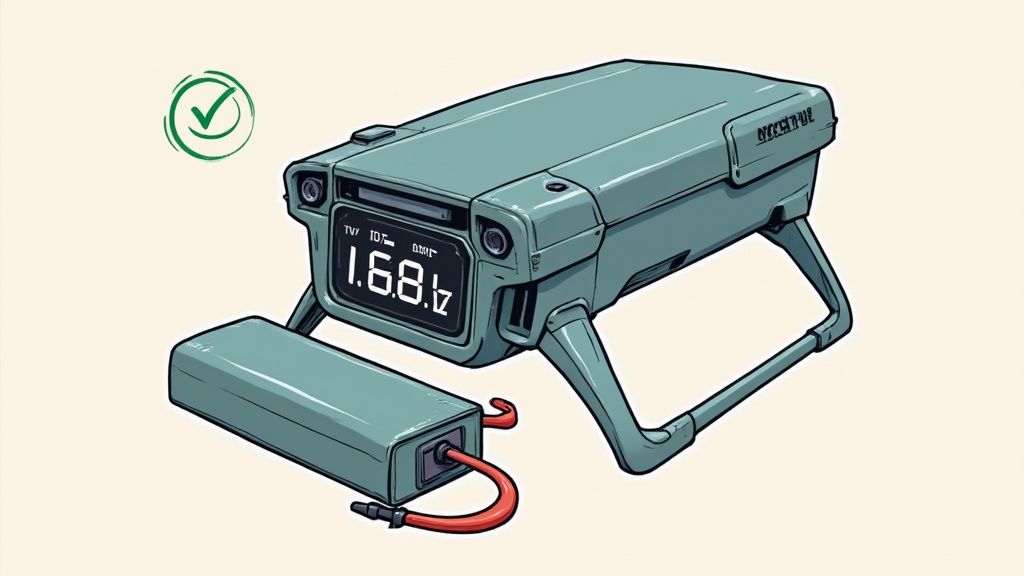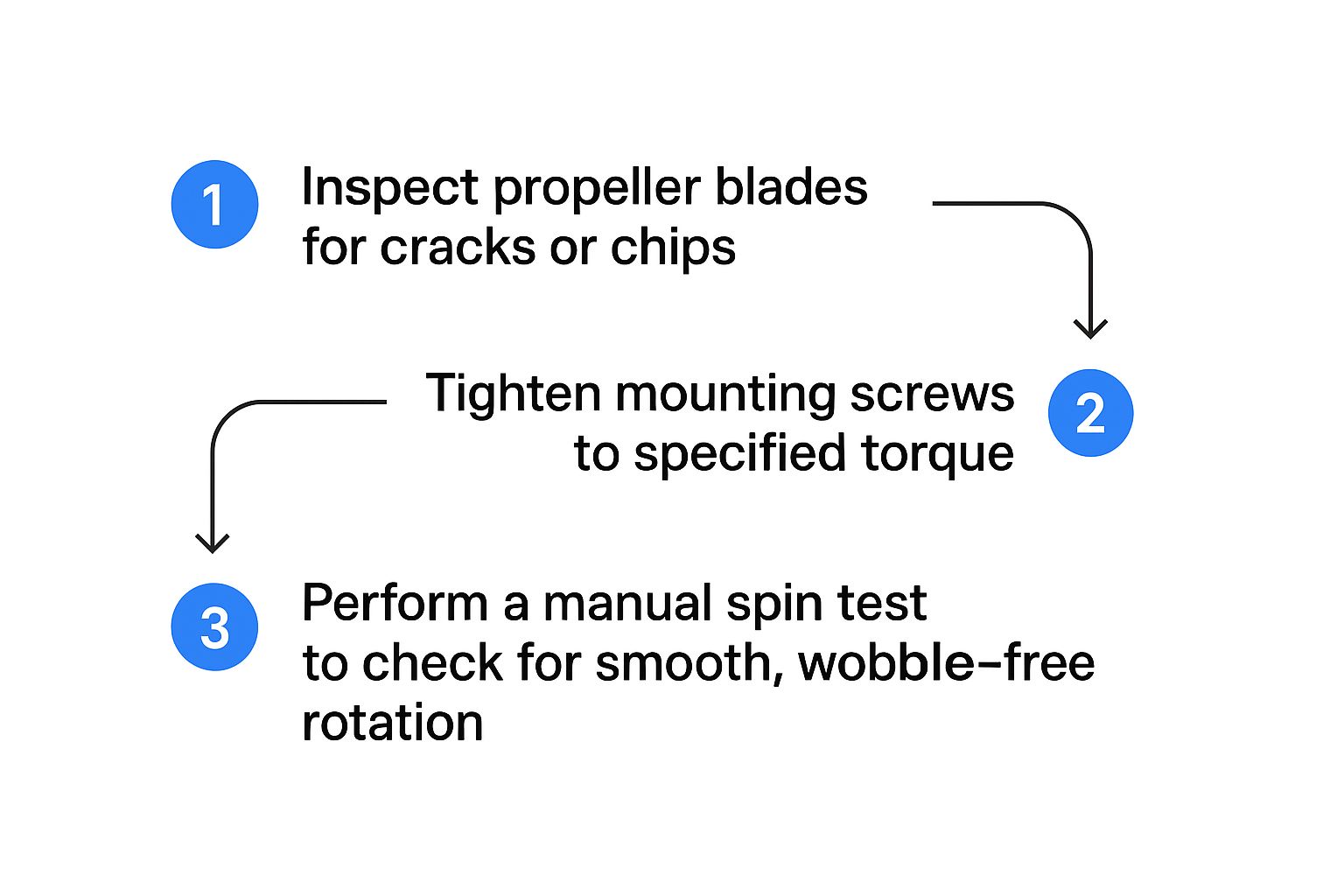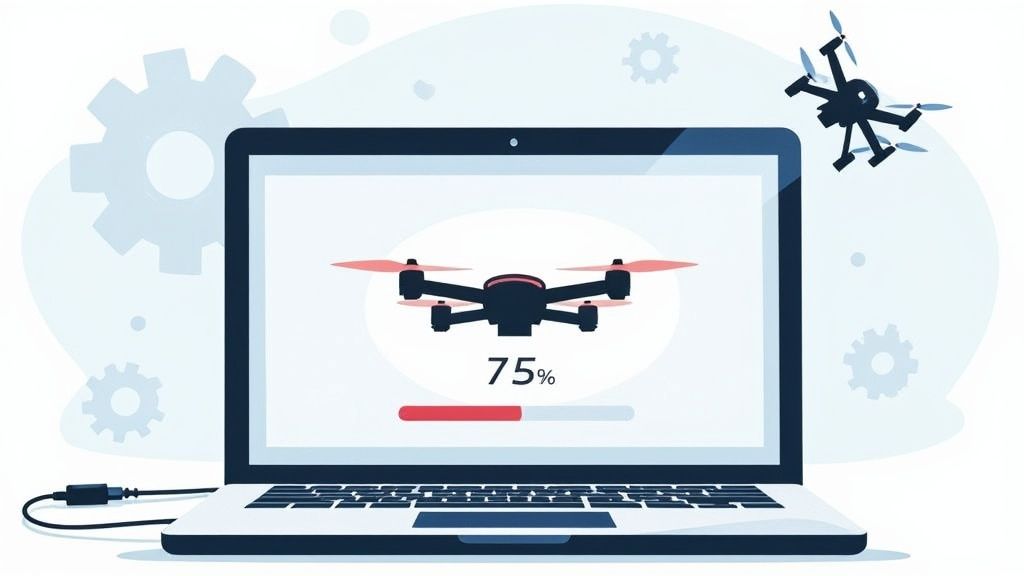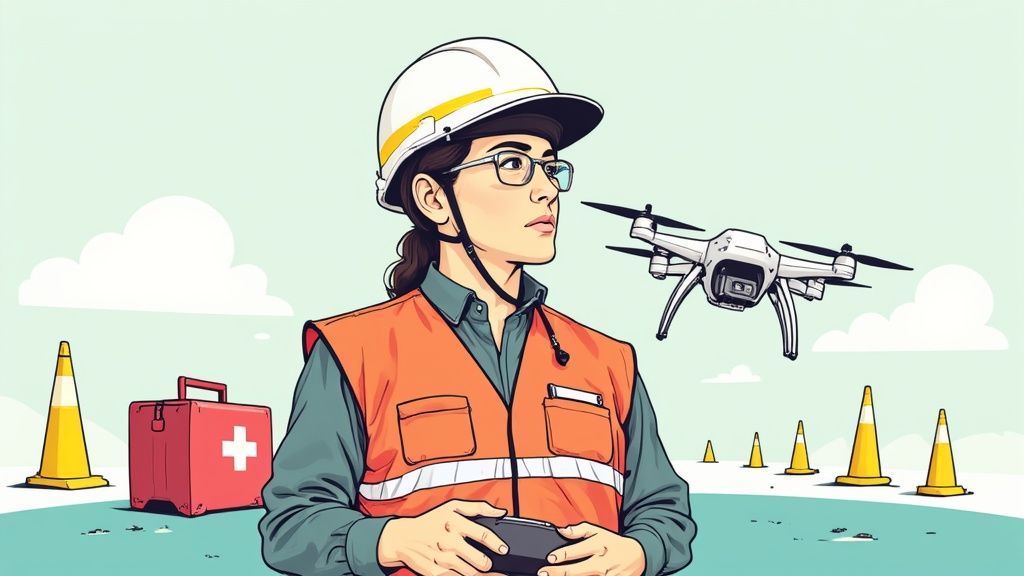Drone Pre Flight Checklist: Essential Safety Tips
- Paul Simmons

- May 19, 2025
- 11 min read
Updated: May 20, 2025
Why Every Pilot Needs a Drone Pre-Flight Checklist

Skipping your drone pre-flight checklist might seem tempting to save time, but it's a dangerous shortcut. Much like pilots of traditional aircraft, drone operators must ensure their equipment and surroundings are safe before flying. This systematic check protects your drone investment and your standing as a responsible pilot.
The Importance of Pre-Flight Checks
Thorough pre-flight checks drastically reduce crashes and equipment malfunctions. It's comparable to driving a car: you wouldn't start driving without checking your fuel, tires, and mirrors. A drone pre-flight checklist serves the same purpose, helping identify potential issues before they become mid-air emergencies. A loose propeller or low battery, for example, could easily turn a simple flight into a costly accident.
Pre-flight checks are also vital for regulatory compliance. The Federal Aviation Administration (FAA) mandates these checks under Part 107 for safe drone operations. One compelling reason for these checklists is their proven effectiveness in accident prevention. Over the last ten years, emphasizing pre-flight procedures has reduced incidents, showcasing their importance for safe skies. Learn more about the benefits of drone pre flight checklists: Drone Pre-Flight Checklist: 7 Key Tips for Safer Flights.
Real-World Implications
Imagine launching your drone for an important commercial shoot only to discover a malfunctioning gimbal mid-flight. A simple pre-flight check could have easily avoided this. These checklists serve as your first line of defense against technical issues and ensure regulatory compliance, whether you're a hobbyist or a professional. You might also find this helpful: Drone Safety Tips: How to Avoid Accidents and Hazards.
Pre-flight checks offer a competitive edge by helping pilots avoid costly accidents and maintain safety. This article provides another helpful resource: Boating Safety Equipment Checklist for safe boating practices. Developing a consistent pre-flight habit is more than a safety measure; it demonstrates professionalism and dedication to responsible drone operation. This dedication builds a stronger reputation, contributing to a more successful experience with drones.
The Complete Drone Pre Flight Inspection Blueprint
Before taking to the skies, a comprehensive pre-flight inspection is essential for every responsible drone pilot. This isn't just a routine checklist; it's about understanding the why behind each check, ensuring a safe and successful flight. Think of it as a pilot's pre-flight ritual, guaranteeing the drone's airworthiness and minimizing potential risks.
Physical Inspection: Ensuring Airworthiness
The physical inspection begins with the drone itself. Propellers should be meticulously examined for cracks, chips, or wear. Even a small imperfection can cause imbalances, leading to instability mid-flight. Next, check the motors. Ensure they are securely mounted, free of debris, and spin freely without any unusual noises.
The drone frame is another crucial component. Examine it thoroughly for cracks or damage, paying particular attention to the landing gear and arms. These areas bear the brunt of landings and are susceptible to stress fractures. Finally, all battery connections should be inspected for secure attachment, corrosion, and damage.

The infographic above illustrates the essential steps for propeller inspection, from a visual check for damage to a spin test. This systematic approach helps ensure your propellers are in optimal condition, reducing the risk of in-flight problems.
Before each flight, take the time to inspect these vital components. A detailed table below outlines key areas to examine, potential issues, and recommended inspection frequency.
Essential Drone Pre Flight Inspection Components A comprehensive breakdown of all physical components that need inspection before each flight.
Component | What to Check | Potential Issues | Inspection Frequency |
|---|---|---|---|
Propellers | Cracks, chips, wear, secure attachment | Imbalance, instability, propeller failure | Before each flight |
Motors | Secure mounting, debris, unusual noises | Motor failure, instability | Before each flight |
Frame | Cracks, damage, especially around landing gear and arms | Structural failure, unstable landing | Before each flight |
Battery Connections | Secure attachment, corrosion, damage | Power failure, battery damage | Before each flight |
This table provides a quick reference for conducting a thorough physical inspection, ensuring the drone is ready for a safe and successful flight.
Electronic Systems Check: Avoiding Mid-Air Surprises
Beyond the physical components, the drone's electronic systems are equally important. After powering on the drone and controller, verify a strong signal and responsiveness. Test the camera settings, ensuring the correct resolution and frame rate. The gimbal should move smoothly without any jerky motions or resistance.
For further guidance on pre-flight preparations, consult these drone pre flight checklist tips. Calibrating the compass and IMU (Inertial Measurement Unit) is crucial. These components are vital for stable flight and accurate positioning.
Power Management: The Lifeline of Your Flight
Battery health is paramount for a successful drone flight. Check the battery's charge level to ensure it's sufficient for your planned mission. Look for any signs of physical damage like swelling or punctures. Battery temperature is another important factor, as extreme temperatures can affect performance.
Learn more about pre-flight preparation in this article on How to master your pre flight checklist. Always have a fully charged backup battery. This provides an extra layer of safety and extends your flight time. By mastering these pre-flight checks, you're not just ticking boxes—you're ensuring a safe and successful flight.
Environmental Factors That Make or Break Your Flight

A critical part of any drone pre-flight checklist is assessing the surrounding environment. This means understanding how wind, temperature, and other factors can affect your flight, and then taking the necessary precautions. This pre-flight routine is crucial for both the safety of your drone and the success of your mission.
Weather Conditions: Wind and Visibility
Wind is arguably the most significant weather factor affecting drone flights. Even a slight breeze can create instability, especially for smaller drones. Before each flight, check the wind speed and direction using an anemometer, a device designed to measure wind.
This wind data is vital for determining if the conditions are safe for your drone model. Different drones have different wind tolerance thresholds, so check your drone's manual for specific guidelines.
Visibility is also critical. Fog, rain, or snow can significantly limit visibility, making it challenging to maintain visual contact with your drone, a legal requirement in many areas. Precipitation can also damage your drone’s electronics and impact its performance. Postponing your flight in bad weather is often the safest course of action.
Airspace Restrictions: Knowing Your Limits
Understanding airspace restrictions is a crucial part of responsible drone operation. Before you fly, use tools like AirMap or B4UFLY to check for Temporary Flight Restrictions (TFRs), controlled airspace, and other no-fly zones.
These digital tools provide real-time information about airspace restrictions, helping ensure you fly legally. Ignoring these restrictions can lead to significant fines and legal consequences.
Site Survey: Identifying Hazards
A thorough site survey is the final piece of the environmental puzzle. Walk around your planned flight area and look for potential hazards. Obstacles like trees, power lines, and buildings present a considerable risk of collision.
Also, identify potential signal interference sources, such as cell towers or radio antennas. These can disrupt communication with your drone. Finally, choose a safe landing zone, free from obstacles and large enough for a controlled descent.
Globally, drone pre-flight checklists are now essential for safe and successful drone operations. The checklist is not just a legal requirement in many places; it's a practical tool. It helps operators ensure their drones are in top condition before each flight. This includes physically checking the drone for any cracks, loose screws, or damaged wires and making sure the drone has the latest firmware and software updates. Learn more: 2025 Predictions for Drone Flight Planning Industry.
By including these environmental checks in your pre-flight routine, you significantly reduce flight risks and improve your chances of a successful mission.
Battery Management: The Heart of Your Pre-Flight Protocol
Battery failures are a major cause of drone incidents. This makes careful battery management a vital part of your pre-flight checklist. A thorough battery check before each flight can prevent mid-air problems and protect your drone. This goes beyond simply looking at the battery indicator. It requires a systematic approach to ensure your battery is healthy and ready for flight.
Inspecting Your Drone Battery
Start by visually inspecting the battery for any physical damage. Look for cracks, swelling, or punctures. Any of these signs could indicate internal damage and pose a serious risk. Also, check the battery terminals for corrosion or loose connections. A poor connection can interrupt power mid-flight, causing a sudden loss of control.
After the physical inspection, check the battery's charge level. Make sure you have enough power for your planned flight, including extra time for unexpected events. Checking battery levels can prevent one of the most common reasons for crashes: running out of power during flight.
Pilots who follow strict pre-flight procedures experience fewer incidents. This demonstrates the value of pre-flight inspections. Learn more about battery checks and other important pre-flight steps: Drone Pre-Flight Checklist: 7 Key Tips for Safer Flights.
Understanding Battery Cell Voltage and Temperature
More advanced checks involve looking at individual battery cell voltages. A large difference between cell voltages can indicate a failing battery. Many "smart" batteries and chargers will give you this information. If you have access to this data, learn how to interpret healthy and unhealthy cell voltage readings.
Battery temperature is also important for performance. Extreme temperatures can significantly reduce battery life and can even cause damage. Before your flight, check the battery's temperature. If it's too hot or cold, allow it to come to a safe operating temperature before flying.
Backup Power and Flight Time Optimization
Always bring a fully charged backup battery. This not only gives you more flight time but also acts as a safety net if your main battery fails. Consider it an essential backup, ensuring you can finish your flight or return safely if there’s a problem.
To get the most out of your flight time, plan your mission carefully. Avoid unnecessary movements that use a lot of power. Maximizing flight time is good, but always keep enough power in reserve for a safe return and landing. This buffer allows you to handle unexpected situations and avoid a mid-air power failure.
Crafting Your Custom Drone Pre-Flight Checklist

A generic drone pre-flight checklist offers a good starting point, but it won't address every specific need. It's similar to a basic recipe – often, you'll need to adjust it based on the ingredients available and the dish you're preparing. Your drone, planned mission, and the location all require unique pre-flight checks. This highlights why a custom pre-flight checklist is vital for safe and successful drone operations.
Adapting to Your Drone and Mission
Different drones come with unique characteristics and operational limitations. A heavy-lift drone carrying a cinema camera, for instance, has completely different pre-flight requirements than a small, lightweight racing drone. Factors like the weight, size, and payload capacity of your drone should be considered when building your personalized checklist.
Your mission also plays a crucial role. An aerial photography mission aiming for smooth cinematic footage requires checks like gimbal stability and camera settings. A mapping mission prioritizing accurate data acquisition, on the other hand, necessitates checks like GPS accuracy and sensor calibration. You might find this helpful: How to fly a drone for beginners - get started today.
Practical Templates for Different Scenarios
Regardless of whether you’re flying a basic quadcopter or a professional hexacopter, a customizable template offers a solid foundation. Begin with a standard checklist, then personalize it by adding checks related to your specific equipment and mission objectives. The following table highlights how different drone missions require specialized checklist items.
The table below, "Custom Checklist Components By Mission Type," provides a comparison of essential pre-flight checks across different drone mission profiles. It helps illustrate how a single checklist won't fit all scenarios.
Custom Checklist Components By Mission Type
Checklist Component | Photography Missions | Mapping/Survey Missions | Inspection Missions | Delivery Operations |
|---|---|---|---|---|
Camera Settings | Resolution, frame rate, focus | Not applicable | Zoom, image quality | Not applicable |
Gimbal Stability | Smooth operation, calibration | Not applicable | Precise control | Not applicable |
GPS Accuracy | Important for location tagging | Critical for accurate data | Important for navigation | Critical for precise delivery |
Payload Security | Secure camera mount | Secure sensor mount | Secure inspection tools | Secure cargo attachment |
As shown in the table, GPS accuracy is critical for mapping and delivery, while camera settings are paramount for photography and inspections. Each mission type has distinct needs.
Incorporating Manufacturer Requirements and Personal Experience
Always consult your drone's manual for any manufacturer-specific pre-flight procedures. This ensures you address all the unique requirements for your particular drone model. Learn from your past experiences, as well. If you encountered a problem during a previous flight, add a relevant check to your checklist to prevent recurrence. For instance, a prior loose propeller incident warrants adding a dedicated propeller security check.
Your pre-flight checklist should be a living document. Continuously update it as you gain experience and as you upgrade your equipment. This ensures your checklist remains relevant and comprehensive, maximizing the safety and success of each flight.
Digital Tools That Transform Your Pre-Flight Process
Gone are the days of cumbersome paper checklists. Today's drone pilots have access to a wealth of digital tools designed to make pre-flight checks more efficient and reliable. These apps offer features that streamline workflows, contributing to safer and more compliant flights. Let's explore how these tools can enhance your pre-flight discipline.
Real-Time Regulatory Updates and Automated Verification
Many digital tools integrate directly with regulatory databases like those from the Federal Aviation Administration (FAA). This provides real-time updates on critical information, including Temporary Flight Restrictions (TFRs) and airspace classifications. This instant access eliminates the need for manual checks, significantly reducing the risk of accidental violations.
Some apps even automate checklist verification, ensuring you've completed all necessary steps before takeoff. This added layer of safety helps catch potential oversights, which can be especially valuable in time-sensitive situations.
Maintenance Tracking and Comprehensive Flight Records
These digital platforms often incorporate features for tracking drone maintenance, logging flight hours, and storing other important data related to your drone operations. Meticulous record-keeping not only simplifies regulatory compliance, but also allows you to identify patterns that can improve overall safety.
For example, tracking battery usage over time helps predict when a battery needs replacement, preventing potential mid-flight failures. This proactive approach to maintenance can prevent costly repairs and ensure the longevity of your equipment.
Comparing Popular Options: AirMap and Kittyhawk
Several applications stand out in the drone software market. AirMap provides comprehensive airspace intelligence and flight planning tools. AirMap offers resources for visualizing airspace restrictions and planning safe flight paths. Kittyhawk is another popular choice, offering similar features with a focus on team collaboration and operational management. Kittyhawk provides solutions for teams to manage drone operations collaboratively. Manufacturer-specific applications also exist, providing features tailored to individual drone models.
Choosing the right tool depends on your individual needs. Consider factors like compatibility with your drone, the types of missions you fly, and whether you need features like team management or automated flight logging.
Selecting Solutions That Enhance, Not Complicate
While digital tools offer many advantages, it's essential to select solutions that truly enhance your pre-flight process without introducing unnecessary complexity. The goal is to streamline your workflow, not bog it down with complicated software. Choose tools that are intuitive, user-friendly, and integrate smoothly into your existing pre-flight routines.
At JAB Drone, we understand the importance of a smooth and effective pre-flight process. Visit our site to explore additional resources on drone safety and best practices: Learn more about drone safety at JAB Drone. By combining a thorough understanding of pre-flight principles with the right digital tools, you can ensure every flight is both safe and successful.
The Competitive Advantage of Thorough Pre-Flight Checks
Thorough drone pre-flight checklists are essential for safety and provide a competitive edge in the professional drone world. Meticulous preparation separates serious drone operators from amateurs, building client trust and contributing to business success. Just as a pilot wouldn't take off without checking their aircraft, a drone pilot shouldn't fly without a complete pre-flight check.
Client Acquisition and Retention
Documented safety procedures greatly influence client acquisition and retention. Clients, especially in demanding industries like film, infrastructure inspection, or precision agriculture, prioritize safety and reliability. Demonstrating a commitment to pre-flight checks reassures clients that their projects are in capable hands, fostering confidence and repeat business.
A strong safety record is also a powerful marketing asset. Showcasing your safety commitment in marketing materials and presentations highlights your professionalism. This can justify higher rates and attract clients willing to pay for peace of mind. Learn more in this article about understanding drone regulations.
Protection During Insurance Claims and Regulatory Inquiries
Detailed pre-flight documentation is invaluable during insurance claims and regulatory inquiries. A thorough checklist serves as evidence of due diligence if an incident occurs. This documentation can be crucial in minimizing liability and potentially saving significant costs associated with equipment replacement and legal fees. It's a record of your actions, demonstrating your commitment to safety and regulatory compliance.
Statistically, pre-flight checklists have improved drone operation safety and efficiency. These checklists help ensure compliance with regulations and minimize accident risks. A typical checklist includes inspecting the drone's condition, checking for software updates, and verifying documentation. Explore this topic further: Spexie's Essential Pre-Flight Checklist for Drone Pilots.
Fostering a Safety Culture
Consistent pre-flight discipline cultivates a safety culture extending beyond individual flights. Safety becomes integrated into every aspect of operations, from equipment maintenance to team communication. This not only reduces accidents but also fosters professionalism and responsibility within the team.
Prioritizing safety protects your equipment and clients and positions your business for long-term success in a competitive industry. A strong safety culture is a valuable asset, contributing to business growth and sustainability.
Ready to elevate your drone operations? Visit JAB Drone for expert advice, product reviews, and resources for safe and effective flying. Explore the World of Drones with JAB Drone




Comments